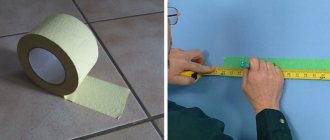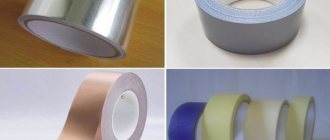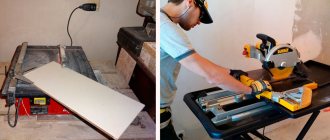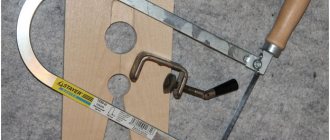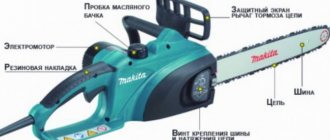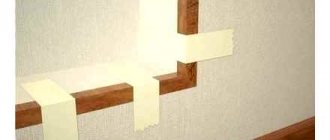Masking tape is a real salvation for construction and painting work. With its help, perfectly straight lines are created on all surfaces, it is resistant to chemicals and temperature changes, and can be removed from the treated areas carefully and without residue. Paper tape is used in many areas, is easy to use, and has a large number of varieties.
Masking tape - what is it and what is it for?
Masking tape is a product with an adhesive surface, its base is rough paper. It consists of two sides: on one of them there is rubber glue, on the second there is a layer of paper that absorbs all liquids or paint (corrugated is the base). The product has many positive characteristics: high elasticity, good gluing ability, ease of operation. Masking tape is easily removed and is used in conditions with high humidity. Let's look at what masking tape looks like: it's a roll of tape that can be painted in different colors, different widths and thicknesses.
The product has many positive characteristics: high elasticity, good gluing ability, ease of operation.
Areas of use
Modern paper-based masking tape has many useful features. First of all, it protects the fabric of walls, ceilings, mirrors and tiles during paint application procedures. This is convenient for decorative painting - the crepe is glued to the desired areas, and paint is applied on top. When the tape is removed, perfectly even geometric shapes remain. In construction, if it is necessary to make holes of different depths, masking paper tape is used as a limiter. The product is wound onto a drill or drill, limiting further drilling.
For decorative painting, the crepe is glued to the desired areas, and paint is applied on top. When the tape is removed, perfectly even geometric shapes remain.
It is convenient when measuring a large area with a measuring tape to attach its edge with a crepe. Painting tape 10 mm allows you to carefully and beautifully make markings: when gluing wallpaper, painting, on tiles, glass, dark and light surfaces. If glass breaks, simply use adhesive to pick up the pieces. During repair and construction work, a small life hack is used: put bolts, plugs, nuts on the tape - everything will be at your fingertips when installing at height or at home. Masking adhesive paper tape is applied around the perimeter of the entrance or interior door, protecting the door leaf and frame from the mounting foam.
To avoid staining the floor with construction waste, make an envelope from a sheet of paper and attach it using 10 mm wide construction tape to the wall. This design will collect all the dust and dirt, leaving the parquet clean. Small, lightweight tools and parts after repairs can be fastened together using tape. It is convenient to glue film or cardboard, joint to joint, and seal windows. The use of masking tape extends to almost all areas of life of a modern person.
It is convenient to glue film or cardboard, joint to joint, and seal windows.
If you need to glue parts of the packaging together, buy yellow or brown wide masking adhesive tape. Blue crepe is relevant in warehouses, for marking containers and products, at post offices or industrial production. The brown shade is ideal for camouflage and is resistant to sudden changes in humidity and temperature.
Why do you need masking tape: recommendations for selection and use
Masking tape is a lifesaver when working with paint: it allows you to create perfectly straight lines at the boundaries of colors and materials. There are other areas in which paper-based tape has proven useful.
Structure of masking tape
Masking tape or crepe differs from regular tape both in structure and purpose. The base of the adhesive tape is paper, but there are also fabric, polyethylene foam and aluminum. The layer of paper is very thin and rough. It is impregnated with rubber-based glue on one or both sides.
The purpose of the paper layer is to absorb liquids and prevent them from spreading beyond the belt. That is why it is corrugated and has excellent hygroscopic properties. Masking tape is easy to attach and quickly remove from any surface.
Important A high-quality tape should not leave marks after removal. This is achieved by a special glue composition.
Areas of use
The properties of crepe tape, such as strength, rapid absorption of moisture, lightness and low price, allow it to be used in a variety of construction and painting works. Scotch tape is suitable for any surface: from walls to ceilings, from plastic to concrete.
Painting crepe is indispensable in the following types of work:
- To protect against the ingress of coloring solutions onto a clean surface.
- For marking color zones in painting, for an even junction of colors.
- To protect surfaces when working with plaster, primer, and polyurethane foam.
- For attaching protective film due to the adhesive properties of the tape.
These are the main ways to use masking tape. But there were other ideas to make repairs and housekeeping easier:
- Removing small glass fragments. The tape is applied to the place where the fragments are scattered or sprayed - the adhesive layer collects them.
- Protection of furniture and other household items from damage during transportation. To do this, seal corners and other fragile areas.
- The rough paper surface will ensure the stability of the drill while working on smooth surfaces. If you need to drill a hole in tiles, just stick a piece of tape to the area.
- For marking not only in painting, but also in carving on various materials.
- It is very convenient to work with tape in needlework.
Types and necessary properties of masking tape
The choice of tape depends on the type of work: in some cases a wide strip of paper is indispensable, in other cases narrow varieties are more convenient. What characteristics to look for when purchasing:
- quality of adhesion;
- compatibility with various paint compositions;
- tensile and crushing strength;
- moisture resistance;
- temperature range for work (optimal from –10 to +120 degrees);
- no contamination after removal.
Tip The most heat-resistant types of crepe are those with an aluminum base.
Now let's look at the types of tape.
Masking tape is available in different sizes:
- The most popular wide tape is 50 mm.
- Narrow tape is also used; its width does not exceed 10-15 mm.
- The length of the roll also matters. For large-scale work, choose a pack from 10 to 70 m.
We recommend: Apparatus for plastering walls. Plastering walls with a compressor.
The density of the tape determines its quality. The optimal layer thickness is 125 microns. This tape is quite thin, but at the same time it has strength and excellent adhesive properties.
According to the structure, single-sided and double-sided masking tape is distinguished. The second type is used for fastening work. It is used on rough wooden surfaces.
For ease of use, masking tape is available in standard white as well as brown, green, yellow, and blue. One of the professional types is blue tape from the manufacturer 3M Company. This color is an indicator of heat resistance. This tape is used for marking cargo. An alternative is the universal wax-based Blue Dolphin tape.
Advice The point about the absence of traces of glue from masking tape is important. Some manufacturers offer a composition that comes off completely even 2 weeks after gluing.
Ribbon Basics
The rules for using masking tape are simple:
- it is pasted only for the period of work; so that no traces are left, the tape must be removed immediately;
- the surface must be dry and clean, otherwise traces of glue will mix with dirt and will be difficult to wash;
- if the tape was not removed on time, old traces of glue are removed using an eraser, soap solution, and in advanced cases, using solvents, vegetable oil (on plastic surfaces);
- You can remove traces of adhesive from heat-resistant surfaces by heating (hair dryer or steam cleaner).
Painting tape is a universal assistant that makes painting and other repair work much easier. Don't skimp on purchasing quality material.
Necessary properties of masking tape
For comparison with other types of adhesive tape, the painting type with a paper base is distinguished by its individual properties. The product has many advantages:
- Large selection of sizes: there is 10 mm masking tape, thinner or thicker, different widths;
- Little weight;
- Relatively low price;
- High adhesion;
- Excellent strength – the tape is resistant to edge-type tears;
- Wide range of temperature conditions (from minus 10 to + 125 degrees Celsius);
- Resistance to changes in humidity and high frosts.
The tape can be combined with different types of paint products, parts, and components. It is simply and easily removed, the sticky residue is quickly wiped off from any surface. Good elasticity, can be used in any conditions.
The masking tape is simply and easily removed, the sticky mark is quickly wiped off from any surface.
Purpose and principle of operation
Masking tape is a type of self-adhesive tape that is a consumable material.
As you might guess from the name, it is primarily used for painting work.
Its function is to protect surfaces when applying paints, varnishes, and plastering.
The main feature lies in low adhesion, which allows, without damaging the surface coating, to remove the tape completely without leaving a trace and to use it everywhere.
Masking tape is used to form clear boundaries when painting, to protect areas (that’s why they are called camouflage tape) where paint is not planned to be applied.
For this reason, tape is indispensable for decorative finishing.
Actually, it is used to paint indoor surfaces, car bodies, etc.
NOTE:
To reduce the labor intensity of the process of applying paintwork to a car, the first masking tape was invented, which eventually received several versions for different conditions of use.
Some types of such tape can be used outdoors in various climate conditions.
When painting, masking tape is used in the following cases:
- When, during repairs, it is necessary to protect surfaces (ceilings, walls, window sills, doors, etc.) from contact with paint, polyurethane foam, plaster and similar materials. During construction, masking tape can replace the tape used to fix the protective film.
- When it is necessary to create a smooth painting area, protecting adjacent surfaces from paint.
- When you need to mark clear boundaries for painting, especially if several areas are planned to be painted in different colors. The marking itself is carried out in both straight and curved lines due to the relatively high flexibility and strength of the tape.
Masking tape is suitable for creating internal and external stencils on a surface, especially given the fact that the lines formed by the tape can always be adjusted.
Non-standard use
In addition to painting work, masking tape is successfully used to solve a wide range of other problems:
- If suddenly any small parts are unpacked, they can be glued to a piece of masking tape to prevent loss. Convenient when organizing a temporary workplace.
- Using tape-crepe, you can apply markings and make notes, any inscriptions on any basis, including a wall with wallpaper, glass, tiles. This feature is extremely useful both in everyday life and in logistics.
- In order to carefully collect the resulting dust and debris when drilling a wall without using a vacuum cleaner, just make an envelope from a sheet of ordinary paper, and then glue it with crepe tape under the entry point of the drill directly to the wallpaper. By the way, by covering the drill with tape in a circle at a certain distance from the edge, you can create an improvised drilling depth limiter.
- Fix the edge of a long tape measure in a certain place; masking tape is also suitable, with which the measuring cloth is firmly glued to the surface being measured.
- If you need to perform precise drilling on a smooth material on the surface of which the drill simply slides (glass, tile), it is enough to stick a crepe tape on it. This will allow you to mark the entry point of the drill into the material and prevent it from slipping.
Among other things, you can use masking tape to seal windows for the winter and safely collect shards of broken glass.
You can also use tape to protect the door leaf during installation by covering it along with the frame around the perimeter.
Crepp is used when sealing seams and joints with sealant, which avoids the latter from getting on the adjacent surface.
Rules for using masking tape (crepe)
The product is applied only to a previously dried, degreased and clean surface. Be sure to take into account the air temperature - it should be positive, ideally room temperature.
Note! Construction tape must be removed after the time indicated on the package. Sometimes this is immediately after the end of the work process. Rubber adhesive bonds quickly and increases adhesion. After a while, it will not be possible to carefully remove the product.
The product is applied only to a previously dried, degreased and clean surface.
How to choose masking tape
We have already figured out what masking tape is, now we need to understand how to choose the right material. Consider the possibility of gluing dusty and dirty surfaces, quick removal after a long time. Check the thin masking tape and its quality: move the strip (no more than 4 cm), then press the same area firmly back and pull again. If you need to use effort when peeling it off again, feel free to buy a skein. Material that peels off easily is of poor quality.
Of course, it is not always possible to check 1 cm masking tape this way. Pay attention to the thickness of the ribbon. A suitable option is thickness parameters of 125, 135 or 140 microns. You can find such a product in construction stores and car repair shops. Shades of strong ribbons: brown, white, yellow. Painting tape 5 mm wide glues well and firmly secures all objects. The main criterion is high adhesion. Pay attention to how many meters there are in the masking tape - this determines how long it will last you.
Consider the possibility of gluing dusty and dirty surfaces, quick removal after a long time.
How to remove traces after deletion
If you used 100mm wide masking tape, you need to know how to remove the remaining rubber adhesive. One effective way is to use simple office adhesive tape. The method works well with plastic items. Attach the material in place of the old one, press firmly. Tear it off with quick jerks several times. This is a soft effect on the plane, so it is impossible to damage or scratch the object.
One effective way to remove glue residue is to use simple office adhesive tape.
Second method: using a solution of baking soda and water. The mass should look like sour cream; the remaining glue is coated with it. You need to wait about 5 minutes, wipe off the composition with a cloth soaked in plenty of water. If necessary, the procedure is repeated. The residue is perfectly wiped off with products containing alcohol: pure ethanol, vodka, aftershave lotions. The latter must be selected without color so that it does not stain the area of application. The principle of operation is simple: a cloth or sponge is moistened in the substance, and the glue is wiped off with careful movements.
The mass should look like sour cream; the remaining glue is coated with it.
Masking tape is a material that leaves sticky marks that eat into plastic well. Plastic products do not tolerate contact with ethyl very well - be careful when cleaning with such compounds. Often deformation or change in shade occurs.
Simple medical alcohol is ideal for such purposes. After wiping the surface, wash it gently with household detergent.
Simple medical alcohol is ideal for such purposes.
It is recommended to use non-abrasive cleaning components. Gel, powder, liquid are allowed. Select a composition with microscopic crystals that cannot scratch the treated areas and act gently. A dishwashing sponge is slightly moistened with the mixture and the necessary areas are wiped. Rubbing is allowed only in particularly difficult places. A spray that works well for cleaning window glass. Simply spray it on and then rinse with clean water at room temperature.
A spray that works well for cleaning window glass.
If possible, use white spirit and gasoline, but remember - there should not be any impurities, because the coating can easily be damaged. In addition, chemical fumes have a negative impact on health. Test on a separate area to check the reaction. If after 10 - 15 minutes the shade and shape of the object has changed, you cannot continue working with liquids.
The situation is the same with acetone - it is a caustic substance that can damage the integrity of a layer of paint or varnish. Suitable for this work are napkins soaked in nail polish remover. To completely eliminate the risk of mechanical and chemical damage, take a composition without acetone.
Suitable for this work are napkins soaked in nail polish remover.
If the item is made of a material that can withstand hot air flows and temperatures, treat the area with a hairdryer or fabric steamer. Heat the tape, pull and it will easily come off completely. Do the same with the remaining adhesive - heat it up and remove it with a slightly damp cloth or microfiber. Steam exposure is an effective method. To do this, it is not necessary to use professional equipment - just breathe on the remaining substance and wipe it off.
If the item is made of a material that can withstand hot air flows and temperatures, treat the area with a hairdryer or fabric steamer.
Experts resort to another proven method - scrub the glue with oil (vegetable, olive). Painting tape 50 is generously moistened with oil, left for 15 - 20 minutes, then carefully peeled off. After this, the mark can be removed very simply with a dishwashing sponge. Next, the area is washed with water and detergent so that no greasy stain remains. It is more difficult to remove such a nuisance, so you should be especially careful.
How to protect walls when painting the ceiling?
If you are spray painting the ceiling, it is best to cover the walls with plastic film. And here's a simple way to do it quickly and easily. Use masking tape with a medium to high tack level. Glue it along the wall, but so that the bottom edge of the tape remains free. Glue a light plastic film to this edge so that its free edge reaches the floor. There is no need to tuck the film under the tape - just first bend the free edge of the tape upward, and then bend it back when you apply the film.
Always test the tape on a small, inconspicuous area to make sure it doesn't leave marks on the wall. Ultra-thin polyethylene film is excellent for such work, since it is inexpensive and weighs quite a bit. At the doorway, make an overlap of two sheets of film to ensure passage.
And painting lena is also capable of this...
